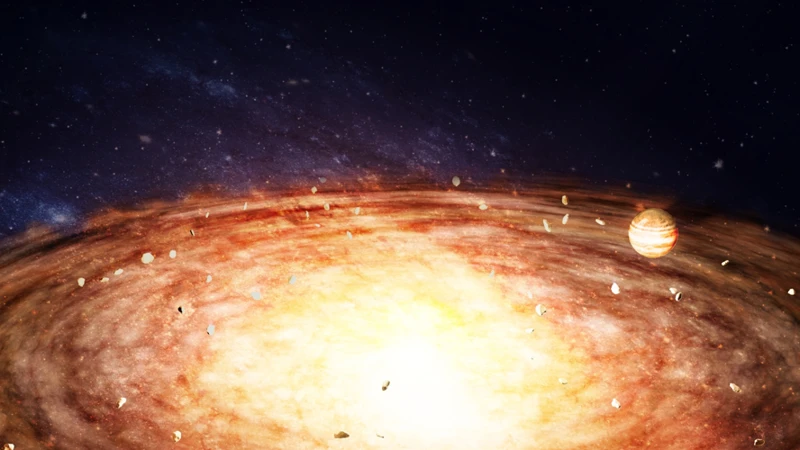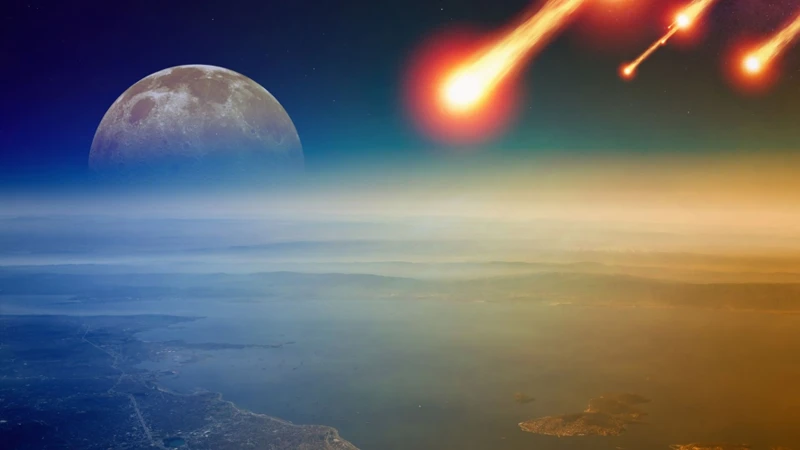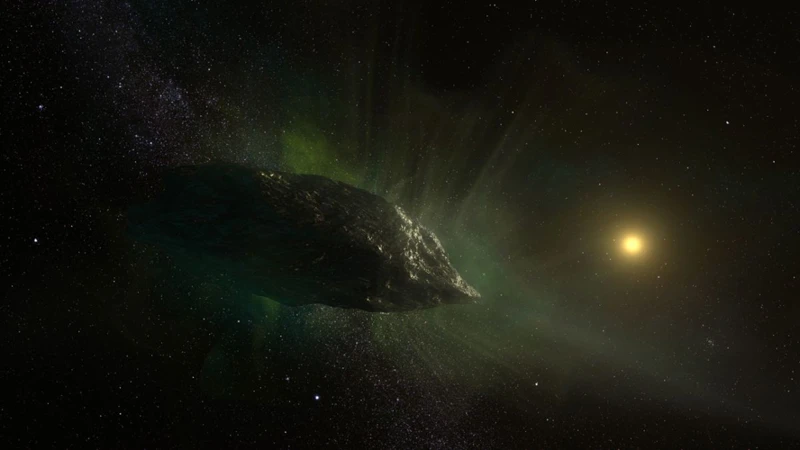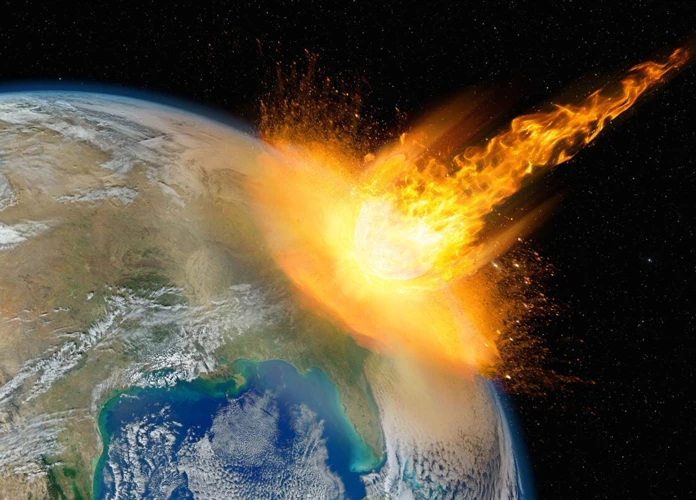Imagine a world where colossal rocks hurtle through space, with the power to shape the very fabric of our planet. These celestial bodies, known as asteroids and comets, have played a pivotal role in Earth’s history, triggering cataclysmic events that have forever altered the course of life. From the demise of dinosaurs to the creation of impact craters, these cosmic visitors have left their mark on our planet. But beyond their destructive potential, asteroids and comets serve as captivating time capsules, providing invaluable insights into the origins of life, the delivery of water, and the evolution of our solar system. However, with the marvels they bring, there also lurks the possibility of future threats. This article explores the formation of asteroids and comets, the impact events that have shaped Earth, their significance as time capsules, and current mitigation strategies to protect our planet from future cosmic encounters. Brace yourself for an extraordinary journey through the cosmic wonders that dot the fabric of our existence.
Contents
- The Formation of Asteroids and Comets
- Impact Events: Cataclysmic Changes on Earth
- Asteroids and Comets as Time Capsules
- Current Threats and Mitigation Strategies
- Conclusion
-
Frequently Asked Questions
- 1. How are asteroids and comets formed?
- 2. What caused the extinction of dinosaurs?
- 3. How do impact craters form?
- 4. How do scientists study the origin of life through asteroids?
- 5. Did asteroids and comets bring water to Earth?
- 6. How do asteroids and comets provide insights into solar system evolution?
- 7. How do scientists identify near-Earth objects?
- 8. What are the current strategies for tracking and monitoring asteroids and comets?
- 9. What are some possible mitigation techniques to prevent asteroid impacts?
- 10. Are there any known asteroids or comets that pose a threat to Earth in the near future?
- References
-
Frequently Asked Questions
- FAQ 1: What is the difference between asteroids and comets?
- FAQ 2: How are asteroids and comets formed?
- FAQ 3: How do asteroids and comets impact the Earth?
- FAQ 4: Did an asteroid impact cause the extinction of dinosaurs?
- FAQ 5: Can asteroid impacts cause the formation of impact craters?
- FAQ 6: How do asteroid impacts disrupt geology?
- FAQ 7: How do asteroids and comets serve as time capsules?
- FAQ 8: How do asteroids and comets provide insights into the origin of life?
- FAQ 9: Can asteroid impacts deliver water to Earth?
- FAQ 10: How do asteroids and comets help us understand the evolution of the solar system?
- References
- Read More
The Formation of Asteroids and Comets

Asteroids and comets, celestial wanderers of the cosmos, originate from different regions of our solar system. Asteroids, often referred to as rocky or minor planets, are rocky remnants that were formed during the early stages of our solar system’s evolution. These cosmic rocks predominantly dwell in the asteroid belt, a region situated between the orbits of Mars and Jupiter. The asteroid belt is home to millions of asteroids, ranging in size from small boulders to massive bodies measuring hundreds of kilometers in diameter. On the other hand, comets, also known as “dirty snowballs,” mainly originate from the icy outskirts of our solar system, residing in areas such as the Kuiper Belt and the Oort Cloud. Comets are composed of icy substances such as water, ammonia, and carbon dioxide, entwined with dust and rocky materials. These enigmatic travelers venture into the inner solar system when influenced by gravitational forces, transforming into ephemeral celestial spectacles known as the tails of comets. This dance between asteroids and comets, originating from diverse corners of our cosmic neighborhood, contributes to the awe-inspiring phenomena that shape our understanding of the universe.
1.1 Asteroid Formation
Asteroids, these celestial fragments that traverse our solar system, come into existence through various mechanisms. Here are some key processes involved in the formation of asteroids:
1. Accretion: During the early stages of our solar system’s formation, a vast cloud of gas and dust, called the solar nebula, surrounded the young Sun. Within this nebula, tiny particles collided and merged, gradually growing in size through a process known as accretion. Over millions of years, these accreted particles formed larger bodies called planetesimals, which eventually evolved into asteroids.
2. Gravity and Collision: As planetesimals continued to accrete material, their increased mass and gravitational pull began to attract nearby objects. Through the force of gravity, these planetesimals would collide and merge with each other, leading to the creation of larger asteroids. The collisions could be violent, resulting in shattered fragments and debris, or more gentle, causing objects to merge and form cohesive structures.
3. Disruption: Not all asteroids remain intact throughout their existence. Occasionally, collisions or gravitational interactions with other celestial bodies can disrupt the structures of asteroids, fragmenting them into multiple pieces. In some cases, the gravitational influence of larger planets, such as Jupiter, can cause asteroids to be ejected from their original orbits and sent into new trajectories within the solar system.
4. Asteroid Families: In certain regions of the asteroid belt, clusters of asteroids with similar compositions and orbital characteristics can be found. These groups, known as asteroid families, are believed to have formed from the fragmentation of a larger parent body due to a significant impact event. Asteroid families provide valuable insights into the history and formation processes of these celestial objects.
The formation of asteroids is a dynamic and ongoing process, continuously shaped by gravitational interactions and cosmic events. By studying their composition, orbits, and characteristics, scientists can uncover the mysteries of our early solar system and gain a deeper understanding of the origins of our cosmic neighborhood.
1.2 Comet Formation
Comets, those mesmerizing celestial bodies with their brilliant tails, are born in the frigid outer reaches of our solar system. Comet formation begins within two main regions: the Kuiper Belt and the Oort Cloud. The Kuiper Belt, situated beyond Neptune’s orbit, is a disk-shaped region brimming with icy bodies. Created from remnants of the solar system’s early formation, these icy bodies coalesce and form what are known as Kuiper Belt Objects (KBOs). When a disturbance, such as the gravitational pull of a passing planet, occurs, some KBOs’ orbits are disrupted, sending them hurtling towards the inner solar system. As these KBOs approach the Sun, they become illuminated, forming the distinctive coma and tail that characterize comets. Similarly, Oort Cloud comets originate from an even more distant region, encompassing the outermost limits of our solar system. This vast spherical shell of icy bodies is thought to be remnants of the early solar system, intermingled with objects captured from nearby star systems. When gravitational disturbances or the passage of a nearby star disturb the Oort Cloud, comets from this region embark on long, elliptical orbits, occasionally venturing into the inner solar system. As these comets draw closer to the Sun, the heat causes the volatile ices within them to vaporize, forming glowing comas and tails that captivate observers on Earth. The formation of comets is a captivating process that involves the interplay of icy bodies, gravitational forces, and the magnificent journey they undertake through the depths of our solar system.
Impact Events: Cataclysmic Changes on Earth

Throughout Earth’s history, impact events caused by asteroids and comets have had profound and cataclysmic effects on our planet’s development. One of the most famous impact events occurred approximately 66 million years ago when a massive asteroid struck the Earth, leading to the extinction of the dinosaurs and numerous other species. These extraordinary collisions create impact craters, which can range from small to colossal in size, leaving lasting geological imprints on the Earth’s surface. Apart from the immediate devastation, these impact events disrupt the Earth’s climate, causing volcanic activity, tsunamis, and fires, leading to widespread ecological disruptions. But amidst the chaos, impact events also play a role as agents of change, triggering geological processes that shape our planet’s landscapes and contribute to its ever-evolving nature. These powerful events serve as reminders of the dynamic relationship between Earth and the vast universe beyond, where even the smallest cosmic fragments can have monumental consequences.
2.1 The Extinction of Dinosaurs
The extinction of dinosaurs, one of the most significant events in Earth’s history, has long captivated the imaginations of scientists and enthusiasts alike. The prevailing theory posits that an asteroid impact played a pivotal role in their demise. This cataclysmic event occurred approximately 66 million years ago when a massive asteroid, approximately 6 miles in diameter, hurtled towards Earth. The impact unleashed unimaginable devastation, causing widespread fires, immense earthquakes, and colossal tsunamis. The resulting impact clouded the atmosphere with dust and debris, blocking out the sun’s rays and leading to a significant drop in temperature. This extended period of darkness, known as the “nuclear winter” effect, severely disrupted the global climate and contributed to the extinction of three-quarters of all plant and animal species, including the dinosaurs. The discovery of the Chicxulub crater, buried beneath the Yucatan Peninsula in Mexico, provided valuable evidence supporting the asteroid impact theory. The study of this impact event has allowed scientists to glean insights into the cataclysms that can arise from celestial collisions, demonstrating the significant influence that asteroids can have on shaping the course of life on Earth.
2.2 Formation of Impact Craters
When asteroids or comets collide with Earth, they create astounding impact craters, leaving indelible marks on the surface. The formation of impact craters is a multi-step process that begins with the rapid release of energy upon impact. The immense energy generates an intense shockwave that propagates through the surrounding rock, causing it to fracture and displace. This initial shockwave is followed by a rebound phase, where the excavation of material occurs. The displaced rock, along with the projectile itself, is ejected outwards in a radial pattern, creating a central uplift within the crater. This uplift is often referred to as the central peak or peak ring. As the ejected material settles, it forms a rim surrounding the central peak, known as the crater rim. Over time, erosion and geological processes may modify the appearance of the crater, but its fundamental structure remains intact. Impact craters provide invaluable insights into the dynamics of impact events and serve as a testament to the powerful forces that have shaped our planet’s geological history. Through the study of impact craters, scientists can unravel mysteries of the past, including the identification of past asteroid and comet collisions and their effects on Earth’s ecosystems. Understanding the formation and characteristics of impact craters opens windows into the dramatic cosmic events that have impacted our world throughout history.
2.3 Geological Disruptions
Geological disruptions caused by the impact of asteroids and comets have left indelible marks on Earth’s surface throughout history. These catastrophic events have the power to reshape landscapes, alter climate patterns, and even induce mass extinctions. When a sizable asteroid or comet collides with Earth, the sheer force of the impact generates intense heat and pressure, leading to an explosion that releases an enormous amount of energy. The energy release results in widespread devastation, including the formation of colossal craters, massive earthquakes, tsunamis, and volcanic eruptions. One prominent example of a geological disruption caused by an impact event is the Chicxulub crater in Mexico, which is believed to have resulted from the asteroid impact that led to the extinction of dinosaurs. The force of the impact caused seismic waves that triggered global earthquakes and volcanic activity, profoundly altering the Earth’s climate and environment. Such disruptions in Earth’s geological history serve as stark reminders of the profound influence that asteroids and comets can have on our planet’s equilibrium. Understanding these disruptions helps scientists gain insights into past events and aids in predicting and mitigating the potential impacts of future celestial encounters.
Asteroids and Comets as Time Capsules

Asteroids and comets, while often associated with catastrophic events, also serve as fascinating time capsules that offer glimpses into the past. These celestial wanderers carry within them valuable information about the origins of life, the delivery of water, and the evolution of our solar system. Studying the origin of life is a profound question that has perplexed scientists for centuries. By analyzing the organic compounds present in asteroids and comets, researchers gain insights into the building blocks of life and the conditions that may have fostered its emergence. Additionally, these cosmic time capsules have been implicated in the delivery of water to our planet. The discovery of isotopic similarities between water on Earth and that found in comets suggests that cometary impacts in the distant past may have brought water, a vital ingredient for life, to our planet. Asteroids and comets offer valuable insights into the evolution of our solar system. By studying their composition and characteristics, scientists can unravel the mysteries of our cosmic neighborhood’s formation and development. They provide a window into the past, allowing us to piece together the story of our celestial origins. Through the study of these extraordinary celestial time capsules, humanity continues to unravel the secrets of our existence in the vastness of the universe.
3.1 Studying the Origin of Life
Studying the Origin of Life on Earth is an intriguing pursuit that involves unraveling the mysteries of our existence. Asteroids and comets, with their unique compositions, offer valuable clues about the building blocks of life. These cosmic travelers may contain organic molecules, including amino acids, which are the fundamental building blocks of proteins and essential for life as we know it. The delivery of such organic molecules to Earth through asteroid and comet impacts could have played a significant role in kick-starting life on our planet. Scientists have studied meteorites, remnants of asteroids that have fallen to Earth, and have discovered evidence of amino acids within them. These discoveries suggest that the ingredients for life may have been present in the early solar system, and the impact events of asteroids and comets may have provided a means of transporting these crucial components to our planet. By studying the organic compounds found in these celestial visitors, scientists can gain insights into the early chemical processes that led to the emergence of life on Earth. This field of research not only helps us understand our own origins but also raises intriguing questions about the potential for life beyond our planet. Exploring the links between asteroids, comets, and the origin of life takes us on a cosmic journey through the vastness of the universe, where the mysteries of our existence await to be unraveled.
3.2 The Delivery of Water
The delivery of water to Earth has been a critical factor in the development and sustenance of life on our planet. Asteroids and comets have played a significant role in this process. When these celestial bodies approach the vicinity of Earth, they can collide with our planet. Upon impact, the icy composition of comets and the presence of water-rich minerals in certain asteroids allow water molecules to be released into Earth’s atmosphere. As a result, water is delivered to our planet through the process known as impact delivery. It is believed that a substantial amount of Earth’s water, including the vast oceans and other bodies of water, may have originated from such cosmic encounters. This hypothesis is supported by the isotopic composition of water found on Earth, which closely matches the composition observed in certain types of asteroids and comets. The delivery of water by asteroids and comets not only contributed to the emergence of life on our planet but also sustained it over billions of years. Understanding the role of these cosmic wanderers in water delivery provides valuable insights into our own origins and the presence of life elsewhere in the universe.
3.3 Insights into Solar System Evolution
Insights into Solar System Evolution: Asteroids and comets offer fascinating glimpses into the evolution of our solar system. These celestial objects are remnants from the early stages of our cosmic neighborhood’s formation, providing valuable clues about the processes that shaped the planets and other celestial bodies. By studying the composition and characteristics of asteroids and comets, scientists can gain insights into the chemical makeup, temperature conditions, and even the presence of organic molecules present during the formation of the solar system. This knowledge helps unravel the intricate interplay of forces that led to the creation of Earth and its neighboring planets. Additionally, the study of impact craters, which are formed when asteroids or comets collide with planetary surfaces, allows scientists to infer the frequency and intensity of these cosmic disturbances over time. These impact events provide valuable data about the dynamics of the solar system and its ongoing evolution. By piecing together the puzzle of asteroids, comets, and impact events, scientists can paint a clearer picture of the processes that have shaped our cosmic home. For more information on celestial phenomena, you can explore the enchanting beauty of aurora borealis and the constellations in the northern hemisphere.
Current Threats and Mitigation Strategies

In the vast expanse of space, the threat of asteroid and comet impacts on Earth remains a harrowing possibility. However, scientists and researchers have dedicated their efforts to identifying, tracking, and mitigating these potential hazards. To safeguard our planet, diligent efforts are ongoing in identifying near-Earth objects (NEOs), including both asteroids and comets, that could potentially cross our path. Advanced telescopes and monitoring systems allow astronomers to systematically scan the skies, categorizing and prioritizing the objects that pose the highest risk. Through tracking and monitoring programs, scientists can continuously monitor the trajectories of these cosmic visitors, making accurate predictions about their potential impact with Earth. In the event of an imminent threat, various mitigation techniques are being explored, ranging from asteroid deflection missions to utilizing spacecraft for targeted impact mitigation. By staying diligent and employing proactive strategies, humanity strives to safeguard our fragile planet from the potential devastation that these cosmic wanderers can bring.
4.1 Identifying Near-Earth Objects
Identifying Near-Earth Objects (NEOs) is an essential step in our efforts to mitigate potential threats from asteroids and comets. Scientists and astronomers adopt various methods to identify these celestial objects and track their trajectories. One approach involves the use of ground-based telescopes equipped with advanced imaging technology that can scan the night sky for any moving objects. These telescopes can detect and track NEOs by capturing multiple images over a span of time and analyzing their positions in relation to the background stars. Another technique utilized in identifying NEOs is the deployment of space-based observatories. These observatories, positioned outside Earth’s atmosphere, provide a clearer and unobstructed view of the cosmos, enabling scientists to detect smaller and fainter objects with greater precision. Additionally, radar technology plays a crucial role in identifying NEOs by bouncing radio waves off the surface of these objects and analyzing the reflected signals. This technique allows scientists to determine the size, shape, and rotation rate of the NEOs. The data collected through these identification methods are vital in developing early warning systems and refining our understanding of the potential dangers posed by near-Earth objects. By continuously monitoring and identifying NEOs, we can enhance our preparedness and response strategies to safeguard our planet from future celestial encounters.
4.2 Tracking and Monitoring
Tracking and monitoring near-Earth objects (NEOs) is a critical aspect of mitigating the potential threats posed by asteroids and comets. Scientists and organizations around the world have implemented various methods to diligently observe and gather data about these celestial bodies. One crucial approach is the use of ground-based telescopes specifically designed for asteroid and comet detection. These telescopes scan the night sky in search of any anomalous objects that may pose a risk to Earth. Additionally, advancements in technology have led to the development of automated sky surveys that can systematically search vast areas of the sky, identifying and tracking potential NEOs. Space agencies, such as NASA, have initiated missions like the Near-Earth Object Observations (NEOO) Program, which aims to identify, track, and characterize NEOs to provide early warnings and better understanding of their trajectories. By collecting precise data on the orbits, size, composition, and rotation of these celestial visitors, scientists can assess the potential impact hazards they pose to Earth. International collaborations and initiatives, like the International Asteroid Warning Network (IAWN), nurture global cooperation in sharing information and coordinating efforts to track and monitor potentially hazardous asteroids and comets. These endeavors serve as crucial stepping stones in safeguarding our planet from future cosmic encounters. It is through diligent tracking and monitoring that we can enhance our preparedness and response capabilities, giving us the best chances of mitigating the impact of these extraordinary cosmic phenomena.
4.3 Possible Mitigation Techniques
Possible mitigation techniques have been proposed to safeguard our planet from the potential hazards of asteroid and comet impacts. These strategies aim to either prevent impact events altogether or to mitigate the damage caused by such impacts. Here are some of the approaches that scientists and researchers have explored:
1. Deflection Techniques: One method involves altering the path of an incoming asteroid or comet, diverting it away from a collision course with Earth. This can be achieved through various means, including gravitational tractor, where a spacecraft is positioned near the object to exert a gravitational force, slowly changing its trajectory. Another technique is kinetic impact, where a spacecraft collides with the object at a high speed, creating a force that alters its path.
2. Blast Deflection: This technique involves using explosives to alter the course of an approaching object. By detonating explosives near the asteroid or comet, the force generated could potentially push it off its collision trajectory. Extensive research and simulations are necessary to ensure the safety and effectiveness of this method.
3. Gravity Tractor: The gravity tractor concept involves using the gravitational pull from a spacecraft to gradually alter the trajectory of an asteroid or comet. By maneuvering a spacecraft close to the object, the gravitational attraction between the two can be utilized to gradually alter its course over an extended period.
4. Ion Beam Deflection: This technique involves using ion beams to deflect an incoming asteroid or comet. By emitting a stream of ions at high velocity, the kinetic energy transferred to the object can cause a change in its trajectory. However, the technical feasibility and practical implementation of this method are still under investigation.
5. Civil Defense: While not a direct mitigation technique, civil defense strategies can help minimize the impact of an asteroid or comet event. Early warning systems, evacuation plans, and emergency response protocols can save lives and reduce the potential damage caused by such an event.
It is important to note that the effectiveness and feasibility of these mitigation techniques may vary depending on the specific characteristics of the asteroid or comet and the time available for preparations. Continued research, development, and international collaboration are essential in improving our capabilities to protect our planet from these cosmic threats.
Conclusion

In conclusion, the study of asteroids and comets provides us with a unique window into the dynamic history of our planet and the vast expanse of the solar system. These celestial objects, with their cataclysmic impact events, have shaped the Earth in profound ways, from mass extinctions to the formation of impact craters and geological disruptions. But their significance extends beyond these destructive forces. Asteroids and comets act as time capsules, carrying valuable information about the origins of life, the delivery of water to our planet, and the evolution of the solar system itself. By studying these cosmic wanderers, scientists can unlock the mysteries of our past and gain insights into the future. The identification, tracking, and monitoring of near-Earth objects are crucial in mitigating the potential threats they pose. Ongoing efforts to develop mitigation techniques and strategies are essential to safeguard our planet from future cosmic encounters. As we continue to explore the wonders of the universe, it becomes increasingly clear that asteroids and comets are not only celestial marvels but also vital pieces of the puzzle that reveal the intricate tapestry of our existence. So let us marvel at the cosmic ballet of asteroids and comets, embracing the perplexing beauty they offer and embracing our responsibility to protect our home among the stars.
Frequently Asked Questions

1. How are asteroids and comets formed?
Asteroids are formed from the remnants of rock and metal materials that were not incorporated into the forming planets during the early stages of our solar system’s evolution. Comets, on the other hand, are believed to originate from the outer regions of the solar system, where the cold temperatures preserve volatile materials such as water, ammonia, and carbon dioxide.
2. What caused the extinction of dinosaurs?
The extinction of dinosaurs, along with many other species, is widely believed to have been caused by a catastrophic asteroid impact. The Chicxulub impact event, which occurred around 66 million years ago, is considered to be the primary cause of the mass extinction event that wiped out the dinosaurs.
3. How do impact craters form?
When an asteroid or comet collides with a planet or moon, it releases an enormous amount of energy upon impact. This energy causes a powerful explosion, creating a crater. The size and depth of the impact crater depend on factors such as the size of the impacting object, its velocity, and the composition of the target surface.
4. How do scientists study the origin of life through asteroids?
Scientists study asteroids to gain insights into the origin of life on Earth by analyzing their composition. Asteroids can contain organic molecules, including amino acids, which are the building blocks of life. By studying the organic material within asteroids, scientists hope to unravel the mystery of how life may have originated on our planet.
5. Did asteroids and comets bring water to Earth?
Yes, asteroids and comets are believed to have played a significant role in delivering water to Earth. Comets, in particular, contain large amounts of ice, which can vaporize when they enter the inner solar system, releasing water vapor. When these icy bodies collide with Earth, they contribute to the presence of water on our planet.
6. How do asteroids and comets provide insights into solar system evolution?
Asteroids and comets are considered remnants from the early stages of the solar system’s formation. By studying their composition, scientists can gain insights into the conditions and processes that led to the formation of our solar system. This knowledge helps us understand the evolution of planets, moons, and other celestial bodies.
7. How do scientists identify near-Earth objects?
Scientists use various methods to identify near-Earth objects (NEOs). These include ground-based telescopes, space-based observatories, and radar systems. By tracking the positions and trajectories of these objects, scientists can determine if they pose a potential threat to Earth.
8. What are the current strategies for tracking and monitoring asteroids and comets?
Current strategies for tracking and monitoring asteroids and comets involve a combination of ground-based telescopes, space-based observatories, and dedicated asteroid survey missions. These efforts aim to detect, track, and characterize near-Earth objects, providing crucial data for prediction and mitigation purposes.
9. What are some possible mitigation techniques to prevent asteroid impacts?
Possible mitigation techniques for preventing asteroid impacts include deflection strategies. These methods involve altering the trajectory of the asteroid, either by using a kinetic impactor to collide with the object, or by employing gravitational tractor spacecraft to gradually alter its path. Another approach is to detonate a nuclear device near the asteroid to change its course.
10. Are there any known asteroids or comets that pose a threat to Earth in the near future?
Currently, there are no known asteroids or comets that pose an immediate threat to Earth in the near future. However, ongoing efforts are made by scientists and space agencies to identify and monitor potential hazardous objects, ensuring that we are prepared and able to develop mitigation strategies if the need arises.
References
Frequently Asked Questions

FAQ 1: What is the difference between asteroids and comets?
Asteroids are rocky objects that orbit the Sun and are made up of various minerals and metals. Comets, on the other hand, are icy bodies that also orbit the Sun but are composed primarily of water, carbon dioxide, methane, and other volatile compounds.
FAQ 2: How are asteroids and comets formed?
Asteroids are believed to be remnants from the early solar system that never formed into planets. They are thought to have formed through a process of accretion, in which smaller rocks and particles came together to create larger bodies. Comets are believed to have originated in the outer regions of the solar system, where the colder temperatures allowed for the accumulation of ice and other volatile materials.
FAQ 3: How do asteroids and comets impact the Earth?
When an asteroid or comet collides with Earth, it can have significant and often catastrophic effects. The impact can cause widespread destruction, with the potential to trigger earthquakes, tsunamis, and fires. The resulting dust and debris can also block sunlight, leading to a decrease in temperature and potential disruptions to the Earth’s climate.
FAQ 4: Did an asteroid impact cause the extinction of dinosaurs?
Yes, the extinction of dinosaurs is widely believed to have been caused by a massive asteroid impact. Approximately 66 million years ago, a 10-kilometer-wide asteroid struck the Earth near what is now the Yucatan Peninsula in Mexico. This event led to widespread environmental devastation, including long-lasting global darkening and a rapid decline in plant and animal life, ultimately resulting in the extinction of dinosaurs.
FAQ 5: Can asteroid impacts cause the formation of impact craters?
Yes, when an asteroid or comet collides with the Earth’s surface, it can create impact craters. These craters are formed due to the kinetic energy released upon impact, which excavates and displaces the surrounding rock and soil. The size of the impact crater depends on various factors, including the size and speed of the incoming object, as well as the composition of the Earth’s surface.
FAQ 6: How do asteroid impacts disrupt geology?
Asteroid impacts can cause significant geological disruptions. The immense energy released upon impact can create shockwaves that fracture and deform the Earth’s crust. This can lead to the formation of faults, the displacement of rocks, and the melting of surrounding material. These impacts can also introduce new minerals and alter existing geological formations, leaving long-lasting evidence of the event.
FAQ 7: How do asteroids and comets serve as time capsules?
Asteroids and comets contain valuable information about the early solar system and the processes that led to the formation of planets and life on Earth. They are considered time capsules because they have remained relatively unchanged since their formation billions of years ago. Scientists can study their composition to gain insights into the conditions and building blocks that were present during that time.
FAQ 8: How do asteroids and comets provide insights into the origin of life?
It is believed that asteroids and comets may have delivered organic molecules and water to Earth during its early development. These essential ingredients for life could have been preserved in the icy and rocky surfaces of these objects. By studying their composition and analyzing the organic materials present, scientists can gain valuable clues about the origin and evolution of life on our planet.
FAQ 9: Can asteroid impacts deliver water to Earth?
Yes, asteroids and comets are thought to have played a crucial role in delivering water to Earth. Comets, in particular, are composed of a significant amount of water ice. When these icy bodies collide with our planet, the heat of entry melts the ice, releasing water vapor and potentially contributing to the Earth’s water reserves.
FAQ 10: How do asteroids and comets help us understand the evolution of the solar system?
Studying the composition and characteristics of asteroids and comets can provide valuable insights into the formation and evolution of the solar system. These objects have remained relatively unchanged since their formation, providing a glimpse into the building blocks and conditions present during the early stages of our solar system’s development. By analyzing their isotopic ratios, scientists can gain a better understanding of the processes that shaped our celestial neighborhood.
References
- Asteroids, Comets & Meteors: Facts
- The Role of Meteorite Impacts in the Origin of Life
- Asteroid and Comet Impacts







